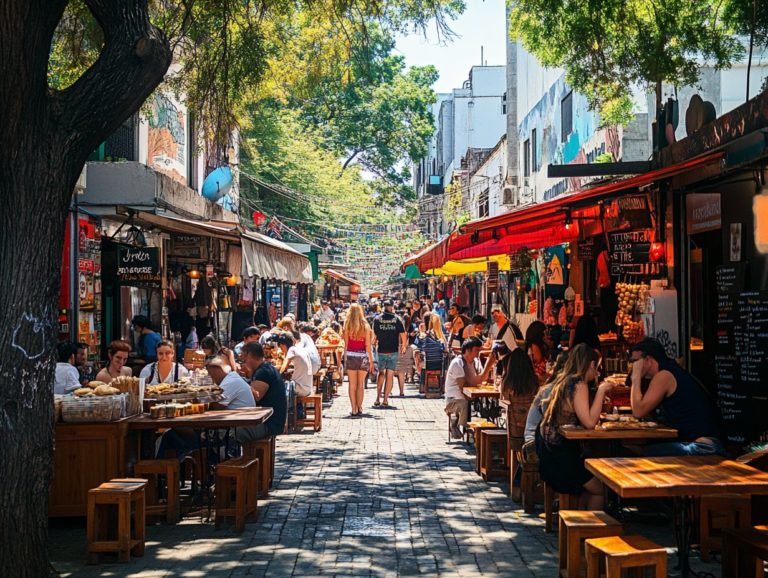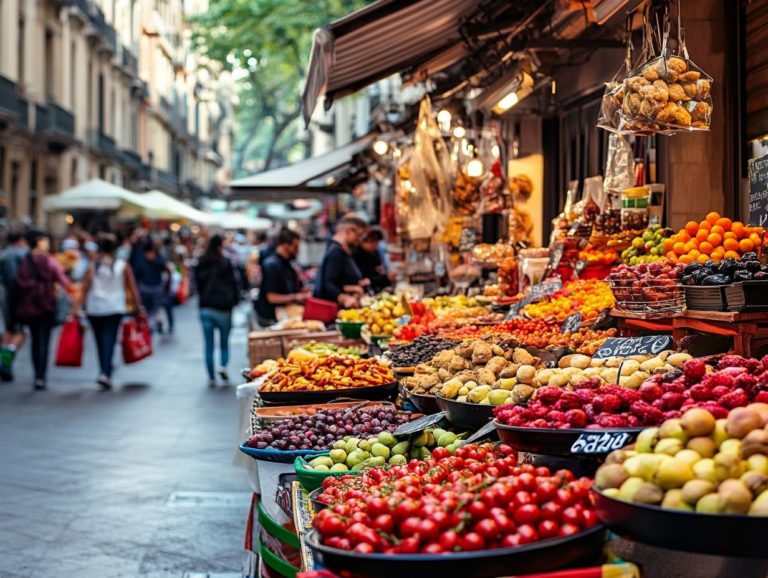Exploring Local Cuisine in Smaller Cities
Smaller cities often hold a treasure trove of culinary delights just waiting for you to discover. Their unique flavors and regional specialties narrate stories of local traditions and ingredients that larger urban centers might overlook.
As you explore, you re in for a treat with hidden gems and must-try restaurants recommended by locals. Each spot offers a culinary experience steeped in the area’s rich heritage. Every bite serves as a taste of history, inviting you to savor the culture that shapes the cuisine.
Navigating menus and understanding local customs will elevate your dining experience, making each meal even more memorable. Dive in and uncover the delicious secrets that these smaller cities have to offer!
Contents
- Key Takeaways:
- Why Smaller Cities are Worth Exploring
- Unique Flavors and Dishes to Try
- Hidden Gems and Must-Try Restaurants
- Cultural Influences on Local Cuisine
- Tips for Exploring Local Cuisine in Smaller Cities
- Frequently Asked Questions
- What is the joy of exploring local cuisines in smaller cities?
- Why should I explore local cuisine in smaller cities?
- What are some benefits of exploring local cuisine in smaller cities?
- Is it safe to try street food in smaller cities?
- What are some tips for exploring local cuisine in smaller cities?
- Can I find vegetarian or vegan options when exploring local cuisine in smaller cities?
Key Takeaways:

- Expand your culinary horizons by exploring local cuisine in smaller cities, where unique flavors and dishes await.
- Discover hidden gems and must-try restaurants with the help of local recommendations and reviews.
- Immerse yourself in the cultural influences of the region and learn about the history and traditions behind the local cuisine.
Why Smaller Cities are Worth Exploring
Exploring smaller cities like those in Tuscany or the quaint towns near Florence opens up a unique opportunity for you to immerse yourself in rich local cultures, indulge in authentic cuisine, and experience the warmth of family-run establishments.
These charming locales offer a more intimate atmosphere. Here, food producers and local chefs flourish, showcasing their craftsmanship and regional specialties.
From the hidden gems of Chicago to the serene landscapes of Mississippi and Sioux Falls, each destination unfolds its own story and character through vibrant food scenes and the culinary culture that sets it apart.
Unique Flavors and Dishes to Try
When you venture into smaller cities, uncovering unique flavors and exquisite dishes becomes an adventure in its own right. Local cuisine often serves as a vibrant reflection of the cultural heritage and traditions that define each region.
From Southern comfort dishes that wrap you in warmth to the intricate flavors revealed during tours that show you how local food is made, every bite tells a story about the area s food culture. Whether you’re savoring the famed Mystic Pizza in Connecticut or indulging in authentic meals shaped by local producers, these gastronomic experiences are further enhanced by insightful reviews that lead you to the finest dining options.
Regional Specialties and Ingredients
Regional specialties and ingredients are essential to shaping the culinary landscape of smaller cities. Locally sourced truffles and other unique ingredients truly elevate your dining experience. These elements not only showcase the area’s agricultural richness but also create a connection between you and the passionate food producers dedicated to their craft.
When you delve into these practices, you’ll discover how each dish encapsulates the essence of the region. This invites you to appreciate the artistry behind the local cuisine.
In many areas, the unique climate and varied geography greatly influence what can be grown and harvested. This results in distinctive flavor profiles exclusive to specific locales. For example, a renowned chef might reveal how the earthy aroma of truffles thrives in the rich, loamy soil of nearby forests, perfectly complementing the farm-fresh vegetables and meats that define local dishes.
Seek out these culinary experiences, not just for the flavors, but to truly understand the dedication of local producers who work tirelessly to bring seasonal ingredients to your table, ensuring authenticity in every bite.
Hidden Gems and Must-Try Restaurants

Hidden gems often await you in the heart of smaller cities. Family-run establishments form the backbone of vibrant food scenes. These must-try restaurants invite you to savor authentic local flavors that truly reflect the character of the region.
Reviews and local recommendations celebrate these spots. They foster a sense of community and tradition, compelling you to immerse yourself in their unique culinary narratives.
Whether you’re indulging in cozy eateries in Sioux Falls or charming bistros in Tuscany, these hidden treasures guarantee unforgettable dining adventures that will elevate your travel itinerary to new heights.
Local Recommendations and Reviews
Local recommendations and reviews are your secret weapons for navigating food scenes in smaller cities. They help you uncover hidden gems and savor authentic local cuisine.
By tapping into insights shared by locals and previous travelers, you can pinpoint the best places to indulge in Southern dishes, comfort food, and unique culinary experiences that might just slip under the radar.
Platforms like Yelp, TripAdvisor, or local Facebook groups can reveal restaurants not always listed in guides. Picture this: a traveler once shared how a simple post in a local group led her to a family-owned diner renowned for its homemade biscuits a dish she still raves about years later.
Local podcasts and city newsletters reveal popular spots and hidden gems. This approach allows you to enjoy authentic experiences that create lasting memories.
Cultural Influences on Local Cuisine
Cultural influences hold profound significance in shaping local cuisine, where traditions and history intertwine to create a rich tapestry of flavors. This is particularly evident in Southern dishes and the regional specialties of smaller cities.
Understanding these influences enhances your travel experience. It allows you to appreciate the stories behind each dish and the cultural heritage that informs local food culture.
From the historical significance of ingredients to the evolution of traditional recipes, the culinary landscape serves as a reflection of a community’s identity and unique narrative.
History and Traditions of the Region
Food tells a story, and every region has its unique tale to share. The history and traditions of a region are intricately woven into its food culture, shaping the local cuisine you encounter while exploring smaller cities.
From time-honored recipes passed down through generations to adaptations influenced by various cultures, understanding this history deepens your appreciation for each dish.
By exploring how cooking has changed over time, you can experience a rich narrative that enhances your dining experiences.
For example, the introduction of spices from far-off lands has transformed simple meals into complex flavor profiles, reflecting centuries of trade routes and cultural exchanges. Festivals often showcase seasonal ingredients, reminding you of the harvest celebrations that once sustained communities.
Local markets buzz with activity, providing you the opportunity to engage directly with vendors who possess invaluable knowledge of their culinary heritage. By savoring signature dishes or participating in traditional cooking classes, you not only indulge in authentic flavors but also immerse yourself in the captivating stories that shape a region’s identity.
Tips for Exploring Local Cuisine in Smaller Cities

Exploring local cuisine in smaller cities is an exciting adventure waiting for you! A handful of essential tips on how to experience local cuisine while traveling cheap can elevate your culinary journey to new heights.
Consider engaging in cooking classes or joining culinary tours. These opportunities provide you with firsthand insights into the local food culture and foster a deeper connection with the community.
Such immersive experiences not only impart valuable cooking techniques but also reveal the rich stories and traditions behind each dish. This transforms every meal into a vibrant celebration of flavor and culture.
Navigating menus and ordering in unfamiliar dining establishments might feel intimidating. However, with the right insights, you can confidently dive into local cuisine and savor the authentic flavors available.
Getting to know regional specialties and common dishes can elevate your dining experience. This knowledge empowers you to make informed choices.
Engaging with the staff about the food culture and asking for recommendations often leads to delightful culinary discoveries that truly capture the essence of the region.
To fully embrace your culinary adventure, understand typical menu terms. These can profoundly influence your dining decisions. For instance, spotting labels like “house special” or “chef’s recommendation” often indicates a restaurant’s pride in specific dishes.
Familiarizing yourself with local delicacies can unveil unique flavors that might otherwise slip under your radar. Don t hesitate to ask the staff about their favorite dishes; these conversations can yield insider knowledge and lead to unexpected culinary delights.
This way, each meal transforms from just food into a memorable experience that lingers long after the last bite.
Etiquette and Customs to be Aware of
Understanding the etiquette and customs surrounding local cuisine is essential if you wish to fully immerse yourself in the dining experience. These practices often reflect the rich traditions of the region.
From proper table manners to specific eating traditions, being aware of these customs enhances your experience and demonstrates respect for the local culture.
This knowledge fosters genuine connections with chefs and food producers, enriching your overall culinary journey. To truly appreciate these social cues, take a moment to observe how locals interact during meals.
Be mindful of regional specialties that might be served in unique ways, such as family-style dining or communal platters. Engaging with local vendors at markets or joining community meals can further deepen your appreciation for the culinary landscape.
This allows you to savor the authentic flavors of tradition that shape every dish.
Frequently Asked Questions
What is the joy of exploring local cuisines in smaller cities?

‘Exploring local cuisine in smaller cities’ describes the act of trying and experiencing the traditional and authentic food of a specific smaller city. It involves going beyond popular tourist spots and sampling local delicacies on a budget to truly enjoy the local food scene.
Why should I explore local cuisine in smaller cities?
Exploring local cuisine in smaller cities allows you to immerse yourself in the culture and traditions of the city. To enhance your experience, learn how to find budget-friendly local cuisine, which gives you the opportunity to try unique and authentic dishes that you may not find in bigger cities.
What are some benefits of exploring local cuisine in smaller cities?
- Support local businesses and the economy.
- Try new and authentic dishes.
- Gain a deeper understanding of the cultural and historical significance of the food.
Don’t miss the opportunity to uncover unique flavors that tell the story of the region! Share your culinary adventures and favorite local dishes with others!
Is it safe to try street food in smaller cities?
Your safety depends on the city and your comfort level. Check online beforehand for popular, reputable street food vendors.
Ask locals or your hotel staff for recommendations.
What are some tips for exploring local cuisine in smaller cities?
Explore the vibrant flavors of unique dishes! Visit local markets and food festivals, and be open to trying new foods.
Can I find vegetarian or vegan options when exploring local cuisine in smaller cities?
Absolutely! Many smaller cities offer a range of vegetarian and vegan options.
Check online before you go, or ask locals for the best spots. Don’t hesitate to share your dietary needs with restaurant staff for more choices.






